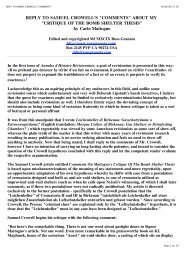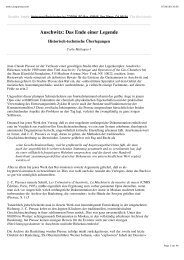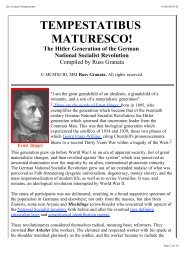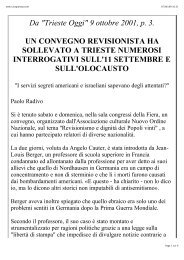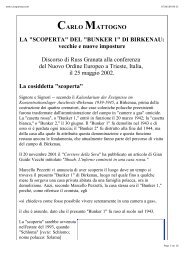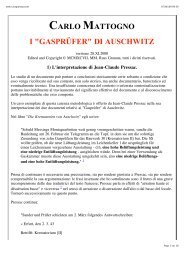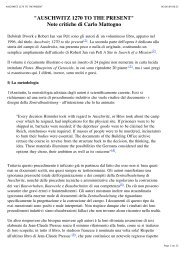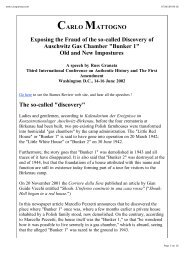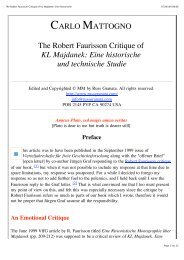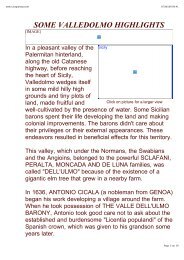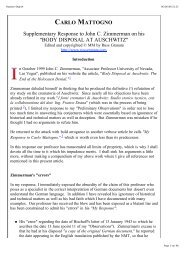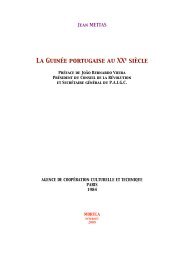CARLO MATTOGNO ON AUSCHWITZ CREMATIONS - morula
CARLO MATTOGNO ON AUSCHWITZ CREMATIONS - morula
CARLO MATTOGNO ON AUSCHWITZ CREMATIONS - morula
You also want an ePaper? Increase the reach of your titles
YUMPU automatically turns print PDFs into web optimized ePapers that Google loves.
<strong>CARLO</strong> <strong>MATTOGNO</strong> <strong>ON</strong> <strong>AUSCHWITZ</strong> CREMATI<strong>ON</strong>S<br />
06/06/09 08:40<br />
<strong>CARLO</strong> <strong>MATTOGNO</strong><br />
<strong>ON</strong> <strong>AUSCHWITZ</strong> CREMATI<strong>ON</strong>S<br />
Translated and Edited by Russ Granata<br />
Copyright MMI by Russ Granata<br />
http://www.russgranata.com<br />
The Barnes Review Second International Conference on<br />
Authentic History and the First Amendment<br />
Washington, D.C., 15 -17 June 2001<br />
Russ Granata Reports on Carlo Mattogno<br />
Thank you for that introduction.<br />
To the facilitators, participants and attendees of this Second<br />
International Conference on Authentic History and the First<br />
Amendment, I extend my greetings as does Carlo Mattogno from<br />
Rome.<br />
Ladies and gentlemen - I was one of those scheduled speakers to<br />
the Beirut Lebanon Conference on Zionism and Revisionism. As<br />
we know, that conference was suddenly canceled after great<br />
pressure was brought to bear upon the government of Lebanon<br />
earlier this year. I am an American, and now I shall speak here in<br />
America's capital city, speech which I was denied to speak in<br />
Lebanon's capital city. Shame on those who would deny us our<br />
Freedom of Speech, and may this conference be remembered not<br />
only as the honoring of America's First Amendment, but also as<br />
another milestone in the pursuit of historical truth!<br />
I shall speak about the work of Carlo Mattogno. I shall first of all<br />
Page 1 sur 33
<strong>CARLO</strong> <strong>MATTOGNO</strong> <strong>ON</strong> <strong>AUSCHWITZ</strong> CREMATI<strong>ON</strong>S<br />
06/06/09 08:40<br />
present 77 Carlo Mattogno points concerning Auschwitz<br />
cremations, and secondly, I shall present just a few points in<br />
Mattogno's latest refutation of the work of Samuel Crowell in that<br />
on-going debate between these two writers.<br />
I have always considered it an honor to be spokesman for that<br />
researcher who has been referred to as 'that modern Renaissance<br />
man'. The last time I spoke to an audience about Mattogno was at<br />
the inauguration of the David Irving Real History USA meetings.<br />
On that occasion, Germar Rudolf was quoted as stating that the<br />
most productive revisionist researcher of the 1990s, was the Italian,<br />
Carlo Mattogno. Then I proceeded to address that David Irving<br />
audience on 40 points concerning that productive Italian. Well, this<br />
time, Ladies and Gentlemen, RussGranataReports on 77 Carlo<br />
Mattogno Points Concerning Auschwitz Cremations. These points<br />
are buttressed by his magnum opus which is being published in<br />
Italy. Its title is I forni crematori di Auschwitz: Studio storicotecnico<br />
con la collaborazione del dott. ing. Franco Deana. [The<br />
Auschwitz Crematories: A Historical-Technical Study with the<br />
collaboration of Doctor of Engineering Franco Deana]. Without<br />
making reference to his major work, it would be impossible for<br />
Mattogno to meaningfully discuss Auschwitz cremations.<br />
Point 1 This work represents the first scientific study on cremations<br />
at Auschwitz, although there had been prior work by others, to<br />
which Mattogno cites as preliminary studies. The cremation<br />
question had been one of the big unsolved problems in the<br />
historiography of the Auschwitz camp. It was in 1989 that it came<br />
out of the collective hysteria closet to which it had for decades been<br />
relegated, and only then did it begin to assume some scientific<br />
connotation, thanks to Jean-Claude Pressac who in that year came<br />
out with Auschwitz: Technique and Operation of the Gas<br />
Chambers.<br />
Point 2 The merit of that French researcher ends here however.<br />
Page 2 sur 33
<strong>CARLO</strong> <strong>MATTOGNO</strong> <strong>ON</strong> <strong>AUSCHWITZ</strong> CREMATI<strong>ON</strong>S<br />
06/06/09 08:40<br />
Pressac attempted to confront the problem on a scientific plain, but<br />
his deficient procedures and conclusions revealed a lack of<br />
technical knowledge which also continued to be evident in his<br />
second book on Auschwitz which appeared in 1993 entitled Les<br />
crématoirs d'Auschwitz: La machinerie du meurte de masse. Such<br />
deficiencies made Mattogno feel that the necessity was even more<br />
pressing for someone to make a rigorous scientific treatment of this<br />
topic.<br />
Point 3 Mattogno wanted to be that someone. He began occupying<br />
himself with the general problem of cremation in the summer of<br />
1987. It was during the next year that he began his valuable<br />
collaboration with the Doctor of engineering, Franco Deana. Dr.<br />
Deana has been indispensable for the scientific organization of this<br />
work. Equally as valuable was the collaboration with a German<br />
engineer whose name must remain unrevealed and whose<br />
assistance unfortunately has not been available since 1991. It is<br />
thanks to these gentlemen, and a few others, that Mattogno was<br />
able to visit for the first time the camps at Auschwitz, Buchenwald,<br />
Dachau, Mauthausen, and Gusen.<br />
Point 4 At first this study was confronted with the technical<br />
problems of duration-time of cremation and the amount of fuel<br />
consumption during the cremation process, but the publication of<br />
Pressac's first book in 1989 gave Mattogno new incentive and<br />
expanded his field of interest and historical level.<br />
Point 5 It was in 1993, at a time when Mattogno thought that his<br />
research was almost complete, that Pressac, in his second book,<br />
indicated the existence of a vast trove of materials on Auschwitz<br />
cremations located in the Viborskaja Street Moscow archives.<br />
Point 6 Mattogno had already seen some parts of these things in<br />
photocopy form in an extract at the Auschwitz State Museum,<br />
based on heretofore little-known documents found by Pressac and<br />
which were published in the 1994 anthology entitled Grundlagen<br />
Page 3 sur 33
<strong>CARLO</strong> <strong>MATTOGNO</strong> <strong>ON</strong> <strong>AUSCHWITZ</strong> CREMATI<strong>ON</strong>S<br />
06/06/09 08:40<br />
zur Zeitgeschichte.<br />
Point 7 In 1995, accompanied by Jürgen Graf and Russ Granata,<br />
Mattogno was able to see in the above-mentioned Moscow<br />
archives, the approximately 88,200 pages of the Auschwitz Central<br />
Building Administration Document Collection which contained an<br />
abundant correspondence between that office and the firm of Topf<br />
and Sons of Erfurt - the same company that constructed the<br />
Auschwitz crematory ovens.<br />
Point 8 In the years 1997 and 1998, Mattogno found important new<br />
documents in archives of Poland and Holland.<br />
Point 9 Among Mattogno's research trips, in the Spring of 1999, he<br />
visited together with Jürgen Graf, both the museum and the<br />
crematorium of Terezin, from which both sites revealed significant<br />
material for his major book.<br />
Point 10 During the Summer of 1999, Mattogno concluded his<br />
research in the Erfurt municipal archive wherefrom on the 5th of<br />
August of the year 1996, he had already obtained custody of a<br />
considerably large amount of documentation concerning the activity<br />
of the Topf company. This was not confined solely to the<br />
construction of crematory ovens.<br />
Point 11 The Structure of the Mattogno Study of the Auschwitz<br />
Cremations:<br />
Through the passing years, Mattogno's initial Study Plan broadened<br />
considerably, both on the historical, as well as on the technical<br />
level - to the point where it became necessary to put this study into<br />
two volumes - one volume to contain its own text, and the other<br />
volume for copies of the documents.<br />
Point 12 This work is being published in Italy by Edizioni di Ar<br />
and is entitled: I forni crematori di Auschwitz: Studio storico-<br />
Page 4 sur 33
<strong>CARLO</strong> <strong>MATTOGNO</strong> <strong>ON</strong> <strong>AUSCHWITZ</strong> CREMATI<strong>ON</strong>S<br />
06/06/09 08:40<br />
tecnico con la collaborazione del dott. ing. Franco Deana. [The<br />
Auschwitz Crematories: A Historical-Technical Study with the<br />
Collaboration of Doctor of Engineering Franco Deana].<br />
Point 13 The Auschwitz gasogene-fired, coke-fueled cremation<br />
ovens, were actually simplifications of civilian crematory ovens -<br />
but since it was so difficult for anyone to find any really<br />
meaningful information concerning these installations, even in the<br />
specialized literature - Mattogno decided he would fill that void by<br />
beginning his study with an explanatory introduction of those<br />
installations. This constitutes Part One of Volume One.<br />
Point 14 Because the Auschwitz crematory ovens were actually<br />
simple combustion systems, Mattogno thought it would be helpful<br />
to preliminarily present general principles of cremation combustion<br />
techniques and the chemical processes which are verified in the<br />
course of a cremation. He presents both the general theoretical<br />
principles and construction of a gasogene-fired, coke-fueled<br />
crematory oven, with an accurate description of its structure and<br />
function. In this way, the reader receives a basis for understanding<br />
cremation technology.<br />
Point 15 After all, since the crematories of Auschwitz were the<br />
result of the technology of their own time, it seemed it would be<br />
helpful to go back over the history of modern cremation with<br />
particular references to gasogene-fired, coke-fueled ovens, such as<br />
those which were installed at Auschwitz - without neglecting the<br />
other heating systems such as gas, electricity, and naphtha. In this<br />
way, the reader is provided basic information regarding the<br />
development of all those combustion installations (including all<br />
their known problems) spanning from the last decades of the 1800s,<br />
up to the Second World War. This historical synthesis of crematory<br />
ovens is carried out with a parallel study of installations designed<br />
for hygienic-sanitary mass cremations (in cases of wars, epidemics,<br />
or other natural disasters ). Mattogno has positioned this<br />
information at the end of his work with a brief analysis of<br />
Page 5 sur 33
<strong>CARLO</strong> <strong>MATTOGNO</strong> <strong>ON</strong> <strong>AUSCHWITZ</strong> CREMATI<strong>ON</strong>S<br />
06/06/09 08:40<br />
contemporary crematory ovens.<br />
Point 16 Scientific cremation experiments which were carried out<br />
in Germany (and in Switzerland) during the late 1920s, are utilized<br />
as a firm experimental basis for confronting and resolving essential<br />
questions of cremation duration and fuel consumption of a<br />
gasogene-fired, coke-fueled cremation oven, which are examined in<br />
detail in two specific chapters.<br />
Point 17 To present the public with as complete a picture as<br />
possible of Auschwitz cremation, Mattogno has not neglected the<br />
legal and statistical aspects with specific reference to Germany.<br />
These topics are presented in Part One of Volume I.<br />
Point 18 In Part Two, Mattogno has outlined the activities of the<br />
Topf company in the planning and constructing of civilian<br />
crematory ovens (which were among the Topf company's various<br />
other installations), describing in detail the structure and operation<br />
of the Topf crematory ovens which were fueled by coke, gas, and<br />
electricity. In this section is also found reports on the numerous<br />
patents (and applications for patents) which were granted, noticed,<br />
or submitted between the 1920s and the 1950s.<br />
Point 19 After his general introduction concerning the production<br />
of Topf company crematory installations for civilian use, Mattogno<br />
then presents information regarding the crematory facilities which<br />
were planned and constructed for the German World War Two<br />
concentration camps. He begins with the facilities at Dachau and<br />
Gusen (they had two-muffled crematory oven cremation chambers<br />
heated by naphtha, which were later converted to coke-fueled<br />
facilities).<br />
Point 20 With this, Mattogno gets into a main theme of this work,<br />
which begins with a documented history of the construction of the<br />
Auschwitz-Birkenau cremation ovens. This is followed by an<br />
accurate presentation of the structure and the operation of these<br />
Page 6 sur 33
<strong>CARLO</strong> <strong>MATTOGNO</strong> <strong>ON</strong> <strong>AUSCHWITZ</strong> CREMATI<strong>ON</strong>S<br />
06/06/09 08:40<br />
technical installations - crematory ovens of two, three, and eight<br />
muffles - and an exposition of the Topf company projections in<br />
case of the necessity of mass cremations in that camp.<br />
Point 21 Three fundamental questions: duration of the cremation<br />
process, capacity of the crematory, and fuel consumption of the<br />
Topf Auschwitz-Birkenau crematory ovens are all scientifically<br />
treated on the basis of a large amount of documentation.<br />
Point 22 To ascertain the duration of the cremation process,<br />
Mattogno draws from experimental data - specifically from the<br />
scientific cremation experiments which used a coke-heated<br />
crematory oven that were carried out by engineer Kessler in<br />
Germany during the late 1920s, as well as experimental tests which<br />
were conducted by the engineer Jones in England during the 1970s<br />
in a gas-heated crematory oven - to an extract of the cremation lists<br />
of the Gusen crematory, and to the lists of the cremations nearly<br />
completed of the crematory of Westerbork. The register lists of the<br />
cremations of Terezin (in which Mattogno studied the vast<br />
compilation of 717 consecutive cremations which took place from<br />
the 3rd of October and the 15th of November of 1943) - all this data<br />
furnishes an important comparison regarding the average duration<br />
of cremations, the results of which constitute the lower limits which<br />
are documented as being possible in the cremation installations of<br />
that era.<br />
Point 23 The treatise of the problem of cremation capacity of the<br />
Auschwitz-Birkenau crematory ovens contains a preliminary study<br />
of the outer limits of the constant functioning of the installations<br />
(which would have been subject to inevitable slag- formation<br />
down-time; the shutting down of crematory ovens for the removal<br />
of slag build-up from the grills) as well as the question of muffle<br />
load - that is regarding the possibility of cremating several cadavers<br />
at the same time [simultaneously] in one muffle. This possibility<br />
becomes excluded on the basis of experimental data (as per the<br />
experience of crematories at Westerbork and Gusen, as well as of<br />
Page 7 sur 33
<strong>CARLO</strong> <strong>MATTOGNO</strong> <strong>ON</strong> <strong>AUSCHWITZ</strong> CREMATI<strong>ON</strong>S<br />
06/06/09 08:40<br />
incinerators for slaughterhouses).<br />
Point 24 The Topf ovens at Auschwitz-Birkenau were designed for<br />
the cremation of single cadavers, and trying to exceed their<br />
technical limits could not have brought any economic advantages in<br />
the cremating.<br />
Point 25 The Soviet-Polish Expert Reports on the Kori coke-heated<br />
crematory ovens in the concentration camps at Lublin-Majdanek,<br />
Sachsenhausen and Stutthof, which are being presented for the first<br />
time in an Italian language translation (leaving aside any purely<br />
propagandistic aspects they may have) actually provide an indirect<br />
proof of the accuracy of the Carlo Mattogno assertions regarding<br />
the duration of a cremation, which is 60 minutes.<br />
Point 26 The Soviet experts who worked out an orientation chart to<br />
determine the combustion time (duration) of cadavers in various<br />
crematory ovens operating at the temperature which was the normal<br />
running temperature of a crematory oven - that is 800 degrees<br />
[Celsius] - ended up with results of a cremation duration time<br />
amounting to 2 hours. At a temperature of 1,000 degrees, which<br />
was the maximum outer limit of the Birkenau ovens, that<br />
corresponded on the chart to a cremation duration of an hour and a<br />
half.<br />
Point 27 The Soviet experts avoided the obstacle of an assumption<br />
in which the temperature of the ovens catches up to 1,500 degrees<br />
Celsius, whereby at such a temperature the duration of the<br />
cremation process would figure to be 15 minutes, which is simply<br />
absurd.<br />
Point 28 Those Soviets also alleged that 4 or 5 corpses were stuffed<br />
altogether into every cremation chamber - and that nevertheless, the<br />
duration-time of the cremations still remained at 15 minutes, which<br />
is twice as absurd.<br />
Page 8 sur 33
<strong>CARLO</strong> <strong>MATTOGNO</strong> <strong>ON</strong> <strong>AUSCHWITZ</strong> CREMATI<strong>ON</strong>S<br />
06/06/09 08:40<br />
Point 29 With these tricks those Soviet experts attributed to the<br />
Auschwitz crematory ovens a cremation capacity absolutely<br />
excessive. Now we shall see the how and the why.<br />
Point 30 In this treatise, Mattogno did not limit himself to simply<br />
assessing the numerical data. He also examined the historical issues<br />
concerning the planning and construction of the Auschwitz-<br />
Birkenau crematory ovens.<br />
Point 31 Heat balance and calculation of crematory oven coke-fuel<br />
consumption, is based upon specific experimental data: that is the<br />
consumption of the Topf two muffle- chambered crematory oven of<br />
the Gusen crematorium. Point 32 The calculations hold account of<br />
the technical data concerning coke in the ovens (with a detailed<br />
study concerning the hourly heat loss in the Gusen oven and in the<br />
two and three-muffle oven at Auschwitz-Birkenau) as well as a<br />
classification of corpses, which come in three main types: normal,<br />
medium, and thin.<br />
Point 33 Fuel consumption (as well as the total combustion air,<br />
theoretical air, and surplus air) is calculated for every type of oven<br />
and for every type of corpse.<br />
Point 34 In order to better evaluate the technical characteristics of<br />
the Topf crematory ovens at Auschwitz-Birkenau, Mattogno also<br />
thoroughly studied the coke and naphtha crematory ovens for the<br />
concentration camps which were constructed by the Hans Kori<br />
company of Berlin - which was the main competitor of the Topf<br />
company, as well as those of the Ignis-Huettenbau company which<br />
were installed in the crematory of Terezin. These were without<br />
doubt the most efficient installations of all those which were<br />
constructed in Europe during the 1940s.<br />
Point 35 The last topic dealt with in Part Two is that of legal<br />
regulations concerning cremation in the concentration camps, and<br />
of the compatibility of the camp crematory oven system to those<br />
Page 9 sur 33
<strong>CARLO</strong> <strong>MATTOGNO</strong> <strong>ON</strong> <strong>AUSCHWITZ</strong> CREMATI<strong>ON</strong>S<br />
06/06/09 08:40<br />
legal regulations.<br />
Point 36 The Mattogno study is based upon absolutely, and without<br />
exception, first-hand sources. The bibliographical sources are listed<br />
in the Bibliography, and those which are documentary are cited in<br />
the notes.<br />
Point 37 Mattogno first of all collected the most significant German<br />
historical and technical literature which still existed on this topic.<br />
He included this information as well as patents which still existed<br />
on civilian crematory ovens (recognizing that many civilian<br />
crematory oven patents were lost in the Second World War due to<br />
the allied bombings [or otherwise unavailable]). At the same time<br />
he has put himself in contact with various manufacturers of<br />
crematory ovens, and he has personally visited crematories in Italy<br />
and in France.<br />
Point 38 To understand the structure and functioning of the Topf<br />
and Kori crematory ovens, Mattogno studied in particular the stored<br />
German documents such as the Zentralbauleitung [central<br />
construction administration] of Auschwitz, as well as other<br />
documents housed in various other European archives. With that, he<br />
inspected and photographed the installations still existing in the<br />
former German concentration camps of:<br />
1. Auschwitz: two Topf double muffled ovens which were badly<br />
reconstructed by the Poles - one Kori moveable naphtha burning<br />
oven;<br />
2. Buchenwald: two Topf triple muffled coke heated ovens (one<br />
prepared also for being heated by naphtha) the same as those<br />
installed in Crematory II and III at Birkenau;<br />
3. Dachau: one Topf double muffled coke heated oven which was<br />
originally a moveable naphtha heated oven, and four Kori coke<br />
heated ovens;<br />
Page 10 sur 33
<strong>CARLO</strong> <strong>MATTOGNO</strong> <strong>ON</strong> <strong>AUSCHWITZ</strong> CREMATI<strong>ON</strong>S<br />
06/06/09 08:40<br />
4. Gusen: one double muffled Topf coke heated oven which was<br />
originally a moveable naphtha heated oven;<br />
5. Mathausen: one Topf double muffled coke heated oven, the same<br />
model as the three double muffled ovens installed in Crematory I at<br />
Auschwitz, and one Kori coke heated oven;<br />
6. Gross-Rosen: one Kori mobile naphtha fueled oven;<br />
7. Lublin: five Kori coke fueled ovens and one Kori mobile naphtha<br />
fueled oven<br />
8. Stutthof: two Kori coke fueled ovens and one Kori mobile<br />
naphtha fueled oven;<br />
9. Terezin: four stationary Ignis-Huettenbau naphtha fueled ovens.<br />
Point 39 In the second volume of his magnum opus, Mattogno<br />
illustrates installations in detail with 360 photographs subdivided<br />
into eleven sections, each section dedicated to a specific<br />
installation. This documentation contains photographs of<br />
installations which up to now have been unknown (such as the<br />
Terezin crematory ovens) or little noted even among the specialists,<br />
such as the crematory ovens of Gusen, Gross-Rosen, Stutthof, and<br />
also of Lublin-Majdanek.<br />
Point 40 It is also to be noted that the photography of these<br />
installations represents a significant new development, showing for<br />
the first time their essential elements, which is indispensable for<br />
understanding their structure and their functioning.<br />
Point 41 The second volume contains 270 documents, many of<br />
which have never been published before or are unknown to<br />
specialists. The first 101 documents refer to civilian crematory<br />
ovens. The documents numbered from 102 to 143 concern the<br />
Page 11 sur 33
<strong>CARLO</strong> <strong>MATTOGNO</strong> <strong>ON</strong> <strong>AUSCHWITZ</strong> CREMATI<strong>ON</strong>S<br />
06/06/09 08:40<br />
civilian activity of the Topf company. Lastly, those documents<br />
numbered 144 to 270 are a selection of the most important<br />
documents concerning the Topf crematory ovens at Mauthausen,<br />
Gusen, Buchenwald, and Auschwitz-Birkenau (plans, designs,<br />
projects, cost estimates, shipping notices, invoices, service<br />
instructions, diagrams, etc.), about the Kori ovens concerning the<br />
above-mentioned areas (above all, original designs and designs<br />
very much cared for by Soviet experts), - these concern technical<br />
and administrative questions and about the crematory bureaucracy<br />
in the concentration camps.<br />
Point 42 The Importance of Cremation Studies to Auschwitz<br />
Historiography.<br />
On 27 January of 1945, the Soviet military entered Auschwitz. For<br />
propaganda reasons, they quickly appointed various investigation<br />
commissions which were supposed to shed light on alleged crimes<br />
perpetrated by the Germans in that camp. The activities of these<br />
commissions naturally did not try to assess what really occurred,<br />
but simply tried to give the appearance of being scientific as per the<br />
political directives of the Communist Party.<br />
Point 43 There is no doubt that the campaign which was the most<br />
nefarious and ominous for western historiography was that one<br />
which was sponsored by four engineers: two Poles and two<br />
Russians, which came up with the number of victims at Auschwitz:<br />
the mysterious 4 million!<br />
Point 44 It is not known with certainty whether this figure was<br />
proposed, or imposed - by the Polish-Soviet commission based on<br />
the so-called eye witnesses, or if it was drafted from their<br />
declarations. Mattogno inclines toward the first hypothesis, because<br />
the Soviets, in order to attempt to destroy National Socialist<br />
ideology, needed to present this as the apex of horror and to<br />
identify National Socialism with Auschwitz.<br />
Page 12 sur 33
<strong>CARLO</strong> <strong>MATTOGNO</strong> <strong>ON</strong> <strong>AUSCHWITZ</strong> CREMATI<strong>ON</strong>S<br />
06/06/09 08:40<br />
Point 45 The Soviets in August of 1944, having already attributed<br />
to the Lublin-Majdanek camp an enormous number of victims: that<br />
is 1,500,000 deaths, 35 times more than the real figure for<br />
Auschwitz at that time, they therefore imposed a figure even more<br />
erroneous, from where we get the necessity of the four million.<br />
Point 46 It is important to determine by what aberrant<br />
pseudoscientific processes the Polish-Soviet investigating<br />
commission came up with such a figure. Those experts, in order to<br />
reach the conclusion to which they had to give a scientific<br />
appearance, did not use any document, but instead they based it<br />
exclusively on their presumed cremation capacity of the crematory<br />
ovens and on the presumed cremation pits at Auschwitz - and not<br />
only did they attribute to these systems a cremation capacity ten<br />
times more than reality, but they multiplied it for an activity-time<br />
full of blunders - that is for the entire existence of the abovementioned<br />
systems, only partially limited by so-called "coefficients<br />
of inactivity" which is rather imaginative. This was the way the<br />
mythical figure of 4 million was presented and remained in vogue<br />
until the year 1989.<br />
Point 47 But here Mattogno is anxious to point out that although it<br />
was fashionable then, it was not factual at that time, and it still is<br />
not factual today. It is certainly important that the first figure [of 4<br />
million] was deflated down to 1,100,000 according to the<br />
Auschwitz State Museum, and even down to 631,000 (the<br />
minimum figure) as per Jean-Claude Pressac. The question as to<br />
just how many instead, is due to the numerical restructuring of the<br />
Auschwitz deceased; it is not following a parallel numerical<br />
restructuring of the capacity of the cremation systems.<br />
Point 48 Let's have Mattogno clear up this essential point. In 1945,<br />
the self-styled eye witnesses enthusiastically embraced the cause of<br />
the 4 million, and to justify it they resorted to technically absurd<br />
declarations; for example, 'witness' Henryk Tauber declared to the<br />
Soviet investigators that the ovens at Birkenau normally cremated 4<br />
Page 13 sur 33
<strong>CARLO</strong> <strong>MATTOGNO</strong> <strong>ON</strong> <strong>AUSCHWITZ</strong> CREMATI<strong>ON</strong>S<br />
06/06/09 08:40<br />
to 5 cadavers within 20 to 25 minutes in every crematory muffle<br />
chamber! - and the other self-styled eye witnesses quickly fell in<br />
line with this order of magnitude and even surpassed it! - and so we<br />
get the self-styled eye witness Dov Paisikovic affirming that the<br />
cremation of one cadaver took 4 minutes!<br />
Point 49 In effect, it is only with such absurdity that they could<br />
"demonstrate" the mystical figure of 4 million. But when this has<br />
collapsed, the absurd testimony of Tauber and his colleagues,<br />
instead of being scattered among the wreckage of Soviet<br />
propaganda, remains set and indestructible, and incredibly, there<br />
are still many adherents of the holocaust who take these people<br />
seriously.<br />
Point 50 At this point it is easy to understand the importance of the<br />
study of cremation in the historiography of Auschwitz, which is<br />
explicit in essential points:<br />
Point (A). The Soviets found in Auschwitz, 536 cadavers and 46<br />
registries of the deceased (Sterbebücher) which contained the<br />
names of approximately 67,200 deaths. Although these registers<br />
referred (with some gaps) to the period from August 1941 to<br />
December 1943, they nevertheless showed the order of magnitude<br />
of the mortality which contrasted in a strident way with the<br />
mythical figure of 4 million. Therefore those registers were very<br />
secretly transferred to Moscow and no commission of inquiry<br />
concerning Auschwitz has ever mentioned them. They reappeared<br />
only after the collapse of communism in Russia. Now the study of<br />
cremation allows verification to determine if the popular figure of<br />
Auschwitz deaths is technically possible, or in other words, is the<br />
story of mass extermination technically possible.<br />
Point (B). History of the alleged homicidal gas chamber at<br />
Auschwitz is still based essentially on pretentious eye witness<br />
testimony: if these witnesses concerning cremations have lied, then<br />
for what reason should we believe in their declarations concerning<br />
Page 14 sur 33
<strong>CARLO</strong> <strong>MATTOGNO</strong> <strong>ON</strong> <strong>AUSCHWITZ</strong> CREMATI<strong>ON</strong>S<br />
06/06/09 08:40<br />
homicidal gassings?<br />
We shall subsequently see what conclusions result from the study<br />
of cremations at Auschwitz, but first we shall clarify essential parts<br />
of this topic, which brings us to:<br />
Point 51 The Beginning of Modern Cremation<br />
Cremating human cadavers had been going on in Europe for more<br />
than a thousand years even before the time of Homer, and human<br />
cremation continued to be practiced until the year 785, when it was<br />
prohibited under penalty of death by Charles the Great with his<br />
decree of Paderborn.<br />
Point 52 In the following centuries, in Christian Europe, [or<br />
Christendom as it was called] the cremation of cadavers fell<br />
completely out of use as a funeral custom. Its revival took place<br />
with the modern cremation movement which began in 1849 when<br />
the German philologist Jakob Grimm delivered a speech on this<br />
topic at the Berlin Academy of Science. The idea was quickly<br />
picked up and disseminated enthusiastically among tireless pioneers<br />
such as the military medical doctor Trusen, the professor<br />
Moleschott, professor Richter, professor Reclam and professor<br />
Küchenmeister. The first cremation in a crematory oven in Europe<br />
occurred on the 9th of October 1874 in Dresden Germany in a<br />
Siemens temporary or prototype crematory oven. The remains of an<br />
English woman were cremated on that occasion. She was Lady<br />
Dilke, who had been the wife of the secretary of state Dilke. This<br />
was followed by the cremation on the 6th of November of the<br />
remains of the wife of Wiesbaden sanitary commissioner Thilenius,<br />
and yet still others, but then these experimental cremations became<br />
prohibited by the government of Saxony.<br />
Point 53 Italy quickly was in the forefront of the modern cremation<br />
movement both from the legal as well as the technical point of<br />
view. The principal of cadaver cremation was recognized by the<br />
Page 15 sur 33
<strong>CARLO</strong> <strong>MATTOGNO</strong> <strong>ON</strong> <strong>AUSCHWITZ</strong> CREMATI<strong>ON</strong>S<br />
06/06/09 08:40<br />
Italian sanitary regulations of the 6th of September of 1874. This<br />
period saw a great fervor of studies and of experiments which<br />
resulted in the construction of several types of crematory ovens.<br />
Modern cremation had to satisfy the prevailing aesthetic and<br />
economic requirements which were formulated for the first time at<br />
a conference convened in Dresden on the 7th of June of 1876.<br />
Point 54 The first crematorium in Europe was erected in Milan<br />
Italy in 1875. It was equipped with a Polli-Clericetti cremation<br />
oven and was inaugurated on the 22nd of January 1876 with the<br />
cremation of the cadaver of Albert Keller.<br />
Point 55 The first German crematory was placed into service in<br />
Gotha on the 10th of December of 1878, and for the following<br />
twelve years, the Gotha crematory remained the only crematory in<br />
all of Germany. During the last decade of the 1800s the number of<br />
crematories in Germany had changed very little, and in 1900 there<br />
were merely five. An increase was recorded only during the years<br />
just before the First World War so that in 1913 the number of<br />
crematories had grown to 40. By the end of the First World War<br />
there were 52. During the period between the two world wars, the<br />
German cremation movement grew as follows:<br />
in 1920 there were 54 crematories, in 1925 there were 66<br />
crematories, in 1930 there were 104 crematories, in 1935 there were<br />
114 crematories.<br />
With the opening of the crematorium at Lahr on the 16th of July of<br />
1939 - the last crematorium before the outbreak of the Second<br />
World War - the number of crematories had reached 122, within<br />
the old Reich, and within the territory of Greater Germany there<br />
existed altogether 131 crematories, of which 5 were in Austria, and<br />
4 in the Sudetanland.<br />
Point 56 Because at first the practice of modern cremation was a<br />
novelty - often taken hostage by the dominant cultural atmosphere -<br />
Page 16 sur 33
<strong>CARLO</strong> <strong>MATTOGNO</strong> <strong>ON</strong> <strong>AUSCHWITZ</strong> CREMATI<strong>ON</strong>S<br />
06/06/09 08:40<br />
consequently there existed only a few crematories in Germany - and<br />
the number of cremations remained very meager for quite a long<br />
time and only began to grow in a consistent way after the First<br />
World War. It remained under 100 until 1886, went up to 1,000 in<br />
1902, and went to 10,000 in 1912. In 1918, the number of<br />
cremations was 15,878 and in the following years it grew quickly<br />
until exceeding 100,000 cremations in the year 1939. Altogether,<br />
from 1878 to 1939 in Germany, 1,201,823 corpses were cremated.<br />
In 1939, the number of deaths in Greater Germany was 1,007,122<br />
of which there were 102,022 bodies cremated. In 1940 there were<br />
108,630 cremations; in 1941 there were 107,103, and in 1942 there<br />
were 114,184.<br />
Point 57 As far as crematories were concerned - at the end of 1938<br />
in Germany there were 130 crematories while in England there<br />
were 47, in Italy 37 (of which 7 were out of service), in Sweden and<br />
Switzerland 22, Denmark 16, Norway 10, Czechoslovakia 9, France<br />
6, Russia 2, and in Belgium, Finland, Holland, Portugal and<br />
Romania - each of those countries had only one crematory. After<br />
Germany, the other European countries recording the largest<br />
number of cremations were England (16,312 cremations),<br />
Switzerland (7,071 cremations), the Protectorate of Bohemia and<br />
Moravia (5,535 cremations), Sweden (4,434 cremations), Denmark<br />
(4,031 cremations), Norway (2,261 cremations) and France (1,340<br />
cremations).<br />
Point 58 But the Japanese hold the world record for the number of<br />
crematories as well as for the number of cremations. Already in the<br />
year 1912 Japan possessed a good 36,723 crematory installations.<br />
In the year 1929, the Japanese cremated 622,492 cadavers.<br />
Point 59 The Crematories in the German Concentration Camps<br />
The institution of crematories in German concentration camps, goes<br />
back to this long tradition. In fact, during the Third Reich when the<br />
first concentration camps were instituted, the administrative SS<br />
Page 17 sur 33
<strong>CARLO</strong> <strong>MATTOGNO</strong> <strong>ON</strong> <strong>AUSCHWITZ</strong> CREMATI<strong>ON</strong>S<br />
06/06/09 08:40<br />
authorities, not anticipating the high rate of mortality which they<br />
were to encounter in the following years, normally sent the<br />
cadavers of their deceased to civilian crematories. It was only<br />
thereafter, when the mortality began to increase at such a high rate<br />
beyond their expectation, that they decided to institute their own<br />
crematories within the camps. Originally Konzentrationslager<br />
Buchenwald used the State Crematory at Weimar. From the 5th of<br />
September of 1938 to the 3rd of May of 1940, the deceased inmates<br />
of the Konzentrationslager Mauthausen were brought to the<br />
Municipal Crematory at Steyr. The Konzentrationslager<br />
Wewelsburg, up to at least December of 1941, brought their<br />
deceased to the crematory at Bielefeld, while the<br />
Kriegsgefangenen- Arbeitslager Gross-Rosen, from the 21st of<br />
August of 1940 until the 28th of January of 1943, used the<br />
Municipal Crematory at Legnitz. And believe-it-or-not at first even<br />
Auschwitz relied upon a civilian crematory - the one at Gleiwitz<br />
(spelled Gliwice in Polish).<br />
Point 60 As soon as the German concentration camps began to<br />
provide their own crematories, they were subjected to the same<br />
strict legislation regulating civilian crematories, as derived from the<br />
"Decree on the Performance of Cremations in the Crematory of<br />
the Sachsenhausen Concentration Camp" which was declared by<br />
Himmler on the 28th of February of 1940. According to these<br />
regulations, the urns containing the ashes of the cremated prisoners<br />
could be buried in a cemetery at the place of origin of the deceased.<br />
Subsequently, with the tragic worsening of the sanitary conditions<br />
of the camps, the crematories became indispensable hygienicsanitary<br />
instruments and the cremations were carried out without a<br />
lot of legal restrictions.<br />
Point 61 Origins of the Auschwitz Crematories<br />
At Auschwitz there originally existed one single crematorium with<br />
three 2-muffled ovens or cremation chambers. For the camp at<br />
Birkenau there was initially projected one crematorium with five 3-<br />
Page 18 sur 33
<strong>CARLO</strong> <strong>MATTOGNO</strong> <strong>ON</strong> <strong>AUSCHWITZ</strong> CREMATI<strong>ON</strong>S<br />
06/06/09 08:40<br />
muffled ovens. In August of 1942 the SS authorities decided to<br />
install at Birkenau another 3 crematories. This decision was taken<br />
as a result of two facts: the expected increase of the population of<br />
the camp having to take on up to 200,000 prisoners, and the<br />
affliction of the terrible typhus epidemic which broke out at the<br />
beginning of July of 1942. So throughout the entire Auschwitz-<br />
Birkenau complex there existed five crematoria described in the<br />
following way:<br />
At Auschwitz itself, the crematory with three 2-muffle chambered<br />
ovens. At Birkenau, Crematories II and III, each with five 3-muffle<br />
chambered ovens, as well as Crematories IV and V, each with 8-<br />
muffle chambered ovens. Taken altogether, there existed therefore<br />
52 muffle chambers at Auschwitz-Birkenau as of July of 1943,<br />
which went down to 48 muffle chambers with the closing of<br />
Crematory I. The equipment of Auschwitz-Birkenau was not on a<br />
par with the other camps, but that does not mean that it was<br />
disproportionate; after all, neither was the natural mortality rate of<br />
Auschwitz on a par with the other camps. For example the camp at<br />
Dachau which had a crematory with a 2-muffle chambered oven,<br />
when in March of 1942, the local authorities projected or planned a<br />
new crematory with 4 ovens, the average mortality rate was at 2<br />
deaths per day; and in the camp at Buchenwald when the two new<br />
3-muffle chambered crematory ovens were installed, the average<br />
mortality rate was between 8 to 12 deaths per day. But on the other<br />
hand, when the SS authorities decided to construct the three<br />
crematories just mentioned, mortality at Auschwitz was at the rate<br />
of 277 deaths per day! So therefore for Auschwitz they projected an<br />
increase in the number of crematory oven muffle chambers 8 times<br />
more than they projected for Buchenwald, but with a daily death<br />
rate 23 times higher.<br />
Point 62 On the other hand, from a letter from the head of the<br />
Auschwitz Zentralbauleitung [central building administration]<br />
dated July the 10th of 1942, it turns out that a crematory with five<br />
3-muffled ovens was planned for 30,000 inmates, which amounts to<br />
Page 19 sur 33
<strong>CARLO</strong> <strong>MATTOGNO</strong> <strong>ON</strong> <strong>AUSCHWITZ</strong> CREMATI<strong>ON</strong>S<br />
06/06/09 08:40<br />
a muffle-inmate ratio of 1 to 2,000 [one muffle for every 2000<br />
inmates]. The 46 muffles at Birkenau were therefore planned for<br />
92,000 inmates, but, as has been stated, according to the initial SS<br />
plans, the Birkenau camp was to hold 200,000 prisoners, and that<br />
would have required 100 muffles. So from a practical standpoint,<br />
the number of muffles at Birkenau were not enough in terms of the<br />
population increase which was planned for that camp.<br />
Point 63 Structure and Operation of the Birkenau Crematory Ovens<br />
The crematory ovens of Auschwitz were simpler systems than<br />
those in use in civilian crematories. The Topf company got the<br />
Auschwitz contracts not because their products were the best, but<br />
simply because they were the least expensive. By assembling two,<br />
three and four crematory ovens in a single structure, the Topf<br />
company created competitive installations because they knew how<br />
to save a remarkable amount of material. But with that, in the<br />
process of cremations, there were problems which did not occur in<br />
the single ovens of the competition. On the contrary, the shoddy<br />
quality of the Auschwitz ovens appeared documentarily from the<br />
correspondence between the Topf company and the<br />
Zentralbauleitung of Auschwitz: it turns out that practically not a<br />
month went by without the verification that there were damages of<br />
various kinds, some so serious as to compromise the functioning of<br />
the entire system, such as the case of Crematory IV, which had to<br />
be shut down after some months of operation.<br />
Point 64 The crematory ovens had gasogene-fired, coke-fueled<br />
cremation chambers known as muffles, and an ash-collecting<br />
receptacle. In the gasogene, which was situated at the posterior part<br />
of the oven, was found the oven hearth grill on which the coke was<br />
burned. The combustion products entered the muffle through an<br />
appropriate aperture and invested the cadaver which lay on a<br />
refractory clay grill. The cadaver was introduced into the muffle<br />
chamber through a special door which was located at the rear of the<br />
oven. The residuals of the cadavers fell through the fissures of the<br />
Page 20 sur 33
<strong>CARLO</strong> <strong>MATTOGNO</strong> <strong>ON</strong> <strong>AUSCHWITZ</strong> CREMATI<strong>ON</strong>S<br />
06/06/09 08:40<br />
grill down onto the ash-pit below, where they were completely<br />
consumed, and then from there the ashes were removed through an<br />
appropriate door located under the cadaver-introductory door. The<br />
air for corpse combustion was supplied from a blower connected to<br />
the oven. The by-products of the combustion of the cadavers, and<br />
the exhaust produced by the draft of the chimney, entered into the<br />
smoke duct from where it went on up into the chimney.<br />
Point 65 During the operation of the crematory ovens, because of<br />
their structure, the chimney gave off smoke, but did not emit<br />
flames, contrary to what was asserted by various so-called eye<br />
witnesses.<br />
Point 66 The Duration of the Cremation Process and the<br />
Consumption of Coke<br />
The cremation of a cadaver is a natural chemical-physical<br />
combustion process which requires its own natural time to be<br />
carried out. In the best civilian crematory ovens working with coke,<br />
the average duration of a cremation took approximately 80 to 90<br />
minutes. The main combustion of the cadaver took place within<br />
approximately 60 minutes, after which the residual particles<br />
dropped down through the bars of the grill onto the ash-pit below,<br />
where they stayed for another 20 to 30 minutes until their complete<br />
combustion. Then the ashes were extracted from the crematory<br />
oven.<br />
Point 67 In the Auschwitz crematory ovens, the average duration<br />
for the completion of a cremation was approximately 60 minutes,<br />
not because these systems were more efficient, but because they<br />
followed a different practice, which went like this: Soon after<br />
approximately 60 minutes, and after the residuals of one cadaver<br />
had dropped down into the ash-pit, another cadaver was quickly<br />
introduced into the muffle chamber. Therefore, two cadavers were<br />
in the oven at the same time, but one cadaver was in its final stage<br />
of the cremation process, while the other cadaver was in its initial<br />
Page 21 sur 33
<strong>CARLO</strong> <strong>MATTOGNO</strong> <strong>ON</strong> <strong>AUSCHWITZ</strong> CREMATI<strong>ON</strong>S<br />
06/06/09 08:40<br />
stage. This system of cremation could not have been carried out in<br />
the civilian crematories because it was illegal.<br />
Point 68 The Auschwitz crematory ovens were planned and built<br />
for the cremation of one single cadaver at a time. The very same<br />
planning engineer - the Topf company engineer Kurt Prüfer - when<br />
he was interrogated by the Soviets in 1946, confirmed that the<br />
crematory ovens of Birkenau could cremate one cadaver per hour<br />
per muffle, and furthermore, he declared that the attempt which was<br />
conducted in his presence to try to cremate two cadavers together in<br />
one muffle, failed.<br />
Point 69 Coke consumption of the ovens varied according to the<br />
model. For a very thin adult cadaver - which in Auschwitz at that<br />
time was just about the norm, this was averaging approximately<br />
32.5 kg of coke fuel for the 2-muffled oven, and approximately 22<br />
kg for the 3-muffled oven, and approximately 16 kg for the 8-<br />
muffled oven.<br />
Point 70 Coke Consumption in 1943<br />
From the 1st of March to the 24th of October of 1943, for the<br />
crematories of Auschwitz-Birkenau, there was supplied altogether<br />
641.5 tons of coke. During this period, the number of prisoners<br />
who died of natural causes was approximately 19,000. The number<br />
of prisoners alleged to have been homicidally gassed is given as<br />
approximately 118,0000 - altogether approximately 137,000 dead<br />
who were allegedly all cremated in the crematory ovens. Now, for<br />
the actual deceased that turns out to be an average coke availability<br />
of approximately 33.8 kg per cadaver, which comprises also the<br />
coke used for heating up the ovens and is therefore quite<br />
compatible with the consumption of the ovens. But if the dead<br />
really had numbered 137,000, the consumption of coke per each<br />
cadaver would had to have been 4.7 kg and that is simply<br />
impossible!<br />
Page 22 sur 33
<strong>CARLO</strong> <strong>MATTOGNO</strong> <strong>ON</strong> <strong>AUSCHWITZ</strong> CREMATI<strong>ON</strong>S<br />
06/06/09 08:40<br />
Point 71 Therefore during the period I have cited above, the<br />
crematory ovens cremated only the cadavers of prisoners who<br />
had died of natural causes.<br />
Point 72 The Duration of the Fire-Resistant Masonry of the<br />
Cremation Ovens<br />
In 1941, the duration of the refractory or fire resistant lining of the<br />
Topf crematory ovens which were heated electrically, was up to<br />
3,000 cremations. However the electrical heating system<br />
guaranteed a uniform diffusion of heat, which prolonged the life of<br />
the refractory masonry lining of the oven walls. In fact the Topf<br />
coke-fueled 2-muffled oven at Gusen, which was a subsidiary camp<br />
of Mauthausen, resisted only about 3,200 cremations, which comes<br />
to 1,600 cremations per muffle. Then after that, the refractory oven<br />
walls had to be dismantled and renovated.<br />
Point 73 As I have pointed out previously--the official death figure<br />
at Auschwitz which is actually given is 1,100,000 persons, the<br />
largest proportion of which--that is at least 800,000 persons--were<br />
supposed to have been cremated in the Crematory, and the rest of<br />
them were supposed to have been cremated out in the open air.<br />
Well, even if we were to assume an extreme limit of 3,000<br />
cremations, the 52 crematory muffles of Auschwitz-Birkenau could<br />
have cremated 156,000 corpses, and the cremation of 800,000<br />
corpses would therefore have required five complete replacements<br />
of the refractory walls of all the crematory ovens. However in the<br />
archives of the Auschwitz Zentralbauleitung, which has the register<br />
of all replacement orders made by the Topf company, there is no<br />
trace of this work, which means that it was never performed.<br />
Therefore it follows that the cremation of 800,000 cadavers in the<br />
crematories of Auschwitz-Birkenau was technically impossible.<br />
Point 74 As far as the cremation in so-called "cremation pits," the<br />
figure which is presented by the so-called eye witnesses is<br />
absolutely excessive. There is no doubt that in the early summer of<br />
Page 23 sur 33
<strong>CARLO</strong> <strong>MATTOGNO</strong> <strong>ON</strong> <strong>AUSCHWITZ</strong> CREMATI<strong>ON</strong>S<br />
06/06/09 08:40<br />
1942 until the opening of the two crematories in March of 1943 -<br />
especially when the high death rate from a typhus epidemic was<br />
raging through the camp - there is no doubt that several thousands<br />
of corpses were burned out in the open - probably with rudimentary<br />
camp-brick furnaces. But that does not have anything to do with the<br />
burning of at least 300,000 alleged homicidally gassed people. This<br />
allegation is categorically refuted by the two American aerial<br />
photographs taken on the 31st of May of 1944, during that crucial<br />
time of an alleged mass extermination of Hungarian Jews, when,<br />
according to the so-called eye witnesses, at Birkenau there was<br />
supposed to have been two enormous cremation pits in the area of<br />
so-called Bunker 2, and another five enormous pits in the courtyard<br />
of Crematory V - pits which we are told swallowed up thousands of<br />
cadavers per day.<br />
Point 75 During that entire period of time, it would have been<br />
possible to cremate on the average out in the open air,<br />
approximately 9,500 cadavers, which would have required a total<br />
burning surface of approximately 7,600 square meters.<br />
Point 76 The two aerial photographs do not show the slightest trace<br />
of any of this alleged activity: In these photographs there appears a<br />
single minuscule column of smoke which arises from the courtyard<br />
of Crematory V and which corresponds to a burning surface area<br />
not greater than 50 square meters. 7,600 square meters against 50<br />
square meters: Here therefore also collapses the story of mass openair<br />
cremation. The small column of smoke mentioned previously, is<br />
explained by the documented fact that on the 31st of May of 1944,<br />
the four crematory facilities in Birkenau were not in operation and<br />
were being repaired, and that therefore cadavers of prisoners who<br />
had died of natural causes had to be burned out in the open air.<br />
Point 77 The Lies of the so-called Eye Witnesses<br />
The scientific study of cremation at Auschwitz demonstrates that no<br />
mass cremation occurred and consequently no mass extermination<br />
Page 24 sur 33
<strong>CARLO</strong> <strong>MATTOGNO</strong> <strong>ON</strong> <strong>AUSCHWITZ</strong> CREMATI<strong>ON</strong>S<br />
06/06/09 08:40<br />
occurred. Furthermore this demonstrates in an irrefutable way that<br />
all - and let me repeat, I say all the so-called eye witnesses have<br />
shamelessly lied about cremations of the cadavers at Auschwitz,<br />
and there does not exist one single witness who has rendered any<br />
plausible technical declaration in this regard.<br />
But after all, since they so shamelessly lied about the cremation of<br />
the cadavers, why should they be believed about the homicidal<br />
gassing of the Jews?<br />
Of course there is NO reason to believe them, because they have<br />
lied about cremations in order to try to cover their lies about<br />
homicidal gassings - the one lie is inseparable from the other, and<br />
the destruction of the one lie inevitably brings the destruction of the<br />
other.<br />
Some Excerpts From The Latest<br />
Carlo Mattogno Refutation<br />
of the Samuel Crowell<br />
Auschwitz Bomb Shelter Theses.<br />
This entire article is posted on the internet at:<br />
http://www.russgranata.com/Crowell-final-eng.html<br />
1. I promised myself not to return to this topic, which, for my part,<br />
I considered to be closed. Nonetheless, Crowell's systematic<br />
distortion of documents and facts in his article "Bomb Shelters in<br />
Birkenau: A Reappraisal "[4] and his unshakeable tenacity for<br />
supporting patently false theses, induced me to reconsider my<br />
decision. Since his thesis has found proselytes among revisionists -<br />
however incredible this may seem - and for the sake of historical<br />
Page 25 sur 33
<strong>CARLO</strong> <strong>MATTOGNO</strong> <strong>ON</strong> <strong>AUSCHWITZ</strong> CREMATI<strong>ON</strong>S<br />
06/06/09 08:40<br />
accuracy, I again take part in the debate. This is also because<br />
Crowell wanted to again put forward arguments that I had already<br />
proved to be without any foundation.<br />
2. One of the assumptions of the Crowell Bomb Shelter Thesis is<br />
that "all air- raid shelter doors were equipped with peepholes."<br />
3. In reality this assumption is completely unfounded as are the<br />
consequences that Crowell draws from it.<br />
4. It is equally false that an anti-gas door with a "peephole" cannot<br />
be a door of a disinfestation chamber, as can be seen from certain<br />
photographs.<br />
5. The case of the gas-tight doors of the Entwesungsanlage at<br />
Majdanek is the clearest example of Crowell's aberrant<br />
methodology. Since 1997 he has been instigating Bradley Smith to<br />
engage the Washington Holocaust Museum in this well-known<br />
sterile controversy.<br />
6. The presence of huge stains of ferro-ferric cyanide in the walls of<br />
the "Entwesungskammer" situated on the north-west shows that<br />
hydrocyanic acid was employed in this chamber; contrary to what<br />
Crowell claims, nothing shows that the disinfestation chambers<br />
served also as air-raid shelters.<br />
7. If Crowell persists in ignoring these proofs and to negate the<br />
evidence, his thesis will be transformed from one of error into one<br />
of imposture.<br />
8. Crowell claims that the "measures" for constructing "civil air<br />
defence" were carried out on the orders of Himmler to Glücks dated<br />
8 February 1943 (his document 12), which in fact have nothing to<br />
do with "bomb shelters." Therefore he believes a directive from<br />
above would have been put into effect modifying the crematoria<br />
into "bomb shelters." Obviously, being a matter of a directive from<br />
Page 26 sur 33
<strong>CARLO</strong> <strong>MATTOGNO</strong> <strong>ON</strong> <strong>AUSCHWITZ</strong> CREMATI<strong>ON</strong>S<br />
06/06/09 08:40<br />
above, it had to be executed in more or less the whole Auschwitz<br />
complex, so that during this period from 8 February to 16<br />
November 1943 several "bomb shelters" must have been<br />
constructed, intended either for detainees or the troops. Crowell<br />
subdivides the documents on "bomb shelters" adduced by him into<br />
three sections which he labels "high level," "mid-level" and "low<br />
level." This tripartite division ultimately serves only to complicate<br />
the essential issue to be resolved, which is simply: between<br />
February and November 1943 were orders imparted and carried out<br />
for the construction of "bomb shelters"?<br />
9. Here is a document which irrefutably proves that Crowell's<br />
ponderings are mere fantasies - and that is why he took good care<br />
not to say a single word about it. This is not surprising since in<br />
order to play it down or disguise the document he would have had<br />
to have recourse to even more foolish fantasies.<br />
10. The suicidal "bomb shelters" of Kremas IV and V<br />
The idea supported by Crowell that the Zentralbauleitung could use<br />
the rooms in the west wing of Kremas IV and V as air-raid shelters<br />
is decisively absurd.<br />
Ladies and gentlemen, I thank you for your kind attention, and wish<br />
you well.<br />
http://www.russgranata.com<br />
info@russgranata.com<br />
POB 2145 PVP CA 90274 USA<br />
Page 27 sur 33



